Model Air raid Shelter-Anderson Shelter-Bombshelter.
Model WWII Air raid shelter.
Making a model WWII Air raid shelter / Anderson shelter. In this part you will add the front of the shelter. For this project, the front of the model is detachable. This is so that you can see inside the shelter in order to get a really good idea of what it must have been like to live in a bomb shelter.
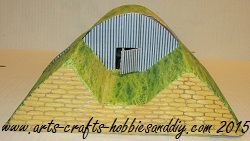
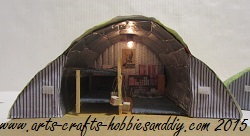

Parent supervision required !!
For this simple project you will need:
A stiff corrugated cardboard box, eg A family size crisps box.
Ruler
A craft knife or Scissors
Pencil or pen
Paint
A paint brush
PVA adhesive or sticky tape
Clothes Pegs
Glue spreader or glue stick
Stage 6: Forming the front of the Air raid shelter.
Now that you have both the sloping sides fixed to the air raid shelter you're now ready to build the detachable front. As shown in the pictures below.
Note: You may also have noticed that I've placed a thin layer of packing foam on top of my shelter. This will help smooth out the where the sloping sides meet the shelter and hide the wire.


To begin with, you will first need to make a template of the front of the Anderson shelter. Place a piece of cardboard against the front of the shelter and then draw around it as shown below.
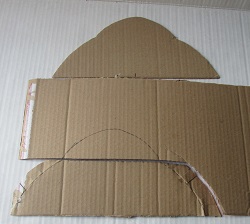
Making the front of the Anderson Shelter.
The front of the shelter is formed by the two main parts. You can see in the picture that I have one template made and have repeated the process to make another template that will form the front edge. Shown above in the main picture with the sandbags.
As with the side pieces that were made earlier, you'll need to allow for tabs on the front piece. As shown above. You'll also notice that I have cut the top part of the template off in line with the top of the sloping sides. Shown below.
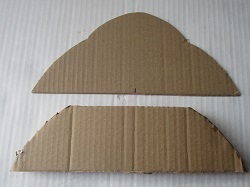
I have also bent the tabs to the shape of the curve using the same method described in Stage 3 of PT1.
With that done, now mark out the WWII Air raid shelter entrance, as shown below.

Again make sure that you allow for tabs before you cut the card.

You should now have two separate pieces that look similar to those shown in the example above. You'll also notice that I have marked out the shape of my front piece on the back template.
Do this by simply folding back all the tabs and then place the front template on top of the back one. Make sure you line up the bottom edge and then draw around it.
Adding the middle and sides to a model Air raid Shelter.
With both the front and back pieces made you now need to add the middle and the sides.
Firstly you'll need to add some tabs to your back piece as shown.
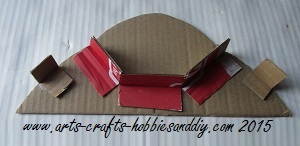
To make the tabs cut some rectangular pieces of card then fold them in half. Secondly stick one-half to your back template so that they just touch the lines you made when you drew around the front piece. As shown above.
Thirdly, link the front and back pieces together.
To do this, first cut a rectangular piece of card to fit the middle, make the card as long as you want your entrance to be. See below.
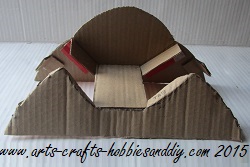
You can now see how it will work as the front of the Anderson Shelter is now starting to take shape. The next thing to do is to make your side pieces and fix them in place.
Making side pieces for an Air raid shelter.
Gently slope the front piece forward and then carefully measure each piece accordingly. You should now have something that looks similar to the example shown. Notice the sloping edges on the side pieces. This is because I want to create the effect of a grass bank that will slope away from the shelter.

Finally stick all your pieces in place and leave to dry.
Hint: It may help to use your pegs to hold the pieces in place while they dry.
Stage 7: Adding some detail to the front of the Air raid shelter.
Once you have finished assembling the front of your bomb shelter you're now ready to add the finishing touches.
Either paint it with the effect that you want or alternatively source an image from the internet and apply it to your finished frame.
How to add a grass effect to a model.
As you can see in the picture below I have chosen a grass effect. To do this find the image you require and copy it into MS Paint. However you may need to scale it down to match the size of your model. As can be seen in my example. Once its scaled down to the correct size go to page setup and set your page to A4. Unless of course you have access to an A3 printer. Remove all borders, although the printer will add a minimum border. This is OK, but check it first in print preview and if you are happy with the image, press print.
The model shown in this tutorial is quite large so it was necessary to print off 4 copies to cover the whole shelter once it had been built.
Once you have printed off your decorative sheets use them to add some finishing touches to the front of your Anderson shelter.
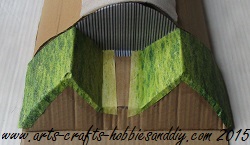
You will also see that I have added a corrugated Iron effect to the shelter front. This can be done exactly the same as adding the grass effect and is discussed earlier.
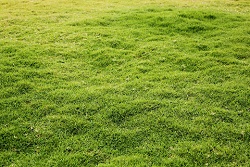
I chose this image because it will add a raised 3D effect to the sides of my air raid shelter. Make sure you overlap the front edge to enable you to stick the edge down. As shown in the example above, carefully make several scissor snips along the overlapping edge. Then glue each piece to the front sloping face. The reason for this is so that when you add your sand-bag effect to the front the cut edges of the sandbags will have a grass effect behind. This will make them look more real as if they are slightly overgrown with grass.
How to create sand bags on a WWII model.
The next thing to do is to create the sandbag effect for the front of the Shelter bank.
Optional.
Stick a piece of paper with a corrugated Iron effect onto the back of the model front and then cut a small doorway as shown in the image below.

To do this take a plain piece of paper large enough to cover the front of the shelter and draw around the profile. Once you have done this you can draw your sandbag effect onto the piece of paper before you cut it out.

Hint: To draw the sandbags, first draw a series of horizontal lines at equal spaces approximately the depth of the sandbag. Once you have done that you can draw each individual bag by adding a series of curved lines at intervals along the horizontal lines as shown below.

Once thats done you're now ready to carefully snip the shape of the sandbags on each side of your template. When you have finished cutting out the shapes you are ready to paint it and bring it to life.
Firstly, add a base coat of a light yellow/brown. Do not apply it too thickly because you need to be able to see your drawn lines below.
Secondly, start to draw on the shapes of the sandbags by drawing over your pencil lines with a brown coloured pencil or pen as shown.
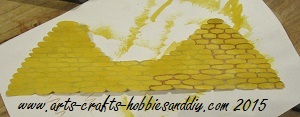
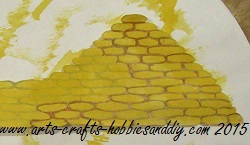
Thirdly, once the whole template is complete you can now add a stitch detail by applying a thin white line to each sandbag, using a sharp white coloured pencil, as shown below
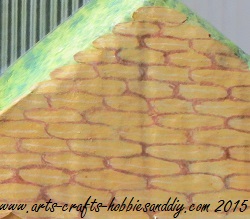
Lastly, you can now stick it to the sloping front of your Anderson Shelter
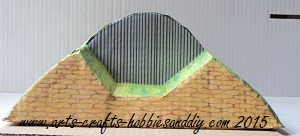
How to make detachable front on a model bomb shelter.
Once you have finished making your model WWII Air raid shelter you will also need to add some Velcro tabs to your front piece to secure it to the rest of your model. As shown in the main pics. This will then allow it to become detachable and enable you to see inside.